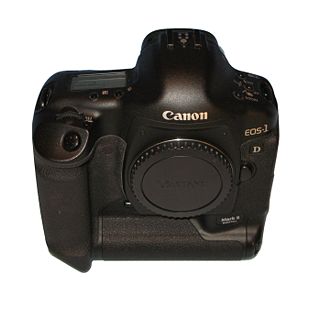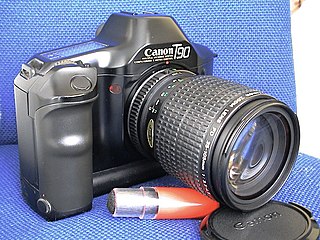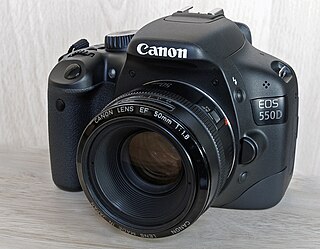Speedlite products
Speedlite is the trade name for Canon's line of external flashes for use with their EOS line of cameras. [4] It is similar but not to be confused with Nikon Corporation's "Speedlight" brand for their flashes. The Speedlite name is also used by Ricoh for its unrelated product line of flash units, such as the Ricoh Speedlite 202.[ citation needed ]
The Speedlite name is intended to indicate that strobe flashes produce much shorter and more intense bursts of light than earlier photographic lighting systems, such as flashbulbs, or the continuous lighting used in some studio situations.[ citation needed ]
The model number indicates the guide number in decimeters, EG, the 430EX has a guide number of 43 m (141 ft) at 100ISO. [5]
90 series flashes
90EX
Introduced in autumn 2012, the Speedlite 90EX is a very small unit designed specifically for the company's first mirrorless interchangeable-lens camera, the EOS M. It runs off two AAA batteries, and can serve as a wireless flash controller. At introduction, the 90EX was bundled with all EOS M kits sold in the EU, though not in the U.S. [6] [7]
100-series flashes
160E
The Speedlite 160E was a compact basic flash with a guide number of 16 m (52 ft), introduced in 1988 to accompany the EOS 750/850. [8] It is unique among Speedlites in being powered not by AA alkaline batteries, but by a 2CR5 lithium photo battery. It was replaced in 1990 by the 200E.
200 series flashes
200E
The Speedlite 200E was a minor upgrade to the 160E, bumping the output to GN 20 m (66 ft) and taking regular AA batteries. [9]
220EX
Introduced in 2000, Speedlite 220EX is a compact entry-level flash unit with a guide number of 22 m (at ISO 100). It operates with four AA batteries, and does not feature any wireless capabilities.
270EX and 270EX II
Speedlite 270EX (introduced in March 2009 [10] ) and 270EX II (introduced in February 2011 [11] ) are compact entry-level flashes with a guide number of 27 m (ISO 100).
270EX features a zoom head which covers 28–55 mm lenses and bounce head capability. 270EX II adds wireless slave mode and remote shutter triggering.
300 series flashes
300EZ
The Speedlite 300EZ was a compact zoom flash released at the introduction of the EOS system in 1987 with the EOS 650. [12] It has a guide number of 30 m (98 ft), takes 4 AA batteries, and incorporates automatic zooming of the flash head to match the angle of illumination to EF lenses in the range of 28 to 70mm. [13] It also has a visible-light auxiliary AF illuminator which projects a pattern of red lines on the subject to aid autofocusing in dark environments.
320EX
In 2011, Canon introduced a new flash that has a built-in LED light. One reviewer noted that the flash occupied a completely new niche in the Canon flash lineup, "slotting between the 270EX II and the 430EX II", and added that it did not replace a previous model. [14]
The LED can be used as a spotlight to see objects in dim light before taking a photo, [15] but is mainly present to provide fill light for video shooting. [14] The aforementioned reviewer also stated that the LED could be used in some situations as a substitute for a standard flashlight. [14]
380EX
This unit is very similar to 430EX in terms of E-TTL functions and power levels. It does not feature an LCD screen like 400 series systems but has several LEDs indicating zoom position and other functions. It is the first E-TTL unit from Canon sold as a dedicated flash for the first E-TTL cameras - EOS 50 (Elan II) and EOS 50e (Elan IIe), which were introduced in 1995.
400 Series Flashes
Canon's external flashes with model numbers in the 400 range tend to be their mid-range external flashes. They all tend to have the ability to adjust the direction of the flash via a swivel head, which allows the photographer to bounce the flash off walls, ceilings, and other objects, diffusing the light that hits the subject and reducing the harsh shadows associated with on-camera flash. The 400 series differs from the higher end 500 series mostly by lacking a remote controller.
420EX
The Speedlite 420EX is an external flash formerly made by Canon. The Speedlite 420EX is one of Canon's older mid-range flashes, being replaced by the 430EX in 2005. It was primarily intended for users wanting to step up from the entry-level flashes, as well as for use as a slave flash along with the more advanced Speedlite 550EX flash.
Compared to its predecessor, the 380EX, it provided slightly more power, an improved autofocus assist beam, tilt and swivel (the 380EX could only tilt), and the ability to serve as a slave in Canon's wireless multiple-flash system. [16] Like the 380EX, the 420EX did not provide user controls (other than enabling and disabling high-speed sync); any flash-related settings, such as exposure compensation or second-curtain synchronization, had to be set using the body.
Its autofocus assist system was designed to cover Canon's autofocus layouts with between 1 and 7 autofocus points; it was not designed to cover the 45-point autofocus layout used by higher-end bodies. It used two lamps to project horizontal and vertical patterns, which matched the line sensitivity of the autofocus sensors used in those autofocus layouts. Either or both patterns would be projected depending on the body being used and the user's selection of autofocus sensor(s).
430EX, 430EX II and 430EX III-RT


The Speedlite 430EX [17] was introduced 22 August 2005 [18] as a replacement for the 420 series. It has Guide Numbers of 141 ft/43m (at ISO 100 and 105 mm). [17] [19]
It can be used as a wireless optically controlled slave with flashes, flash controllers, or cameras which support Canon's infrared control system, including the 580 Speedlite series, the ST-E2 flash controller, and cameras such as the 7D Mark II. It supports TTL, E-TTL and E-TTL II.
The flash head can swivel up (to 90°), right (to 90°) and left (to 180°). [20] The swivel properties allow the photographer to bounce the flash off walls, ceilings, and other objects, diffusing the light that hits the subject and reducing the harsh shadows associated with on-camera flash.
The 430EX II [19] was announced on June 10, 2008 [21] [22] and improved on its predecessor by adding a stronger, all metal foot with quick release mechanism, silent flash recycling, 20% shorter recycle times and support for setup through the camera's menu system.
The 430EX III-RT was announced in July 2015 and shipped September 2015. [23] It is smaller, lighter, faster, has increased swivel angles, revised controls, and brings master and slave compatibility with Canon's new radio control system in addition to functioning as a slave with the earlier infrared/optical control system.
470EX-AI
The Speedlite 470EX-AI is an external flash made by Canon for use with their EOS line of cameras that was announced on February 25, 2018. It is Canon's first flash to feature AI Bounce, which "determines the optimal bounce angle and swivels into position to capture the appropriate camera exposure and flash output." [24]
500 and 600 series flashes
Canon's external flashes with model numbers in the 500 and 600 ranges tend to be their high end external flashes. All three products so far have included a controller that enables wireless control of other flashes. Another common feature is the ability to adjust the direction of the flash via a swivel head. The swivel properties allow the photographer to bounce the flash off walls, ceilings, and other objects, diffusing the light that hits the subject and reducing the harsh shadows associated with on-camera flash.
550EX

The Speedlite 550EX (introduced September 1998) is a flash made by Canon for use with their EOS line of cameras, primarily the Canon EOS 3. The 550EX can act as a controller that enables wireless control of other flashes. [25] Until the release of the Speedlite 580EX in late 2004, the 550EX was Canon's top-of-the-line flash.
580EX and 580EX II
The Speedlite 580EX (introduced in 2004 with a price of $480) [26] [27] and Speedlite 580EX II [28] are flashes made by Canon for use with their EOS line of cameras. The 580EX was succeeded by the Speedlite 580EX II in early 2008. The flashes in the 500EX series can act as a controller that enables wireless control of other flashes. They also have a slightly stronger maximum flash output and a more durable casing than 430EX units.
Key features of the 580EX II that make it desirable are a built-in PC terminal, easy locking metal foot, faster recycling time, silent charge, a much easier-to-use battery cover and support for setup through the camera's menu system. [29] [30]
The unit is also fully sealed against moisture and weather conditions with silicon gaskets all around. However some better features on the earlier model were dropped like EL backlight on the LCD (580EX II uses simple led back-light) and designated master/slave switch. Both units are made in Japan.
600EX-RT and 600EX II-RT
The Speedlite 600EX-RT [31] was announced on March 2, 2012 alongside the new Canon EOS 5D Mark III. [32] The 600EX-RT features new bi-directional 2.4 GHz wireless radio communication, compatible with the also-announced Speedlite ST-E3-RT transmitter; as well as backwards compatibility with the optical triggering of any combination of Speedlite 580EX II, 580EX, 550EX, 430EX II, 430EX, 420EX, 320EX, or 270EX II flashes.
Both the 600EX-RT and ST-E3-RT may be subject to legal restrictions of use when in their Radio Transmission (RT) mode. Official Canon documentation accompanying these units, "Regions of Use and Restrictions", lists 58 countries where the units do comply with local radio wave regulations. Countries that are not listed include: the Republic of South Africa, Israel, Argentina, Pakistan, to name but a few. Customers are advised to "not use this product in areas it was not designed for". [33]
The 600EX II-RT (June 2016) improved on flash firing among other features. [34]
EL-100
The Speedlite EL-100 is a compact size flash available since October 2018. It weighs only 190g (without batteries) while providing full swivel and bounce support as well as ability to control other Speedlite flashes in master mode. [35]
EL-1
The Speedlite EL-1 was announced in October, 2020, and released in February, 2021, replacing the 600EX II-RT as Canon's flagship flash.
New features include rechargeable Li-ion Battery Pack (LP-EL), upgraded Xenon Flash tube and internal cooling system, as well as dust- and water-resistance of the same standard as found on Canon's EOS-1D camera.
ST-E2 transmitter
The Speedlite Transmitter ST-E2 is a camera-mounted infrared controller for Canon's flashes. [36] It allows for multiple off-camera flashes to be fired in E-TTL mode without the need for connecting wires. [37]
Flashes being triggered by the ST-E2 can be assigned to either group A or group B, and the ST-E2 can be configured to with a user-set ratio of flash output between the two groups, with ratios varying from 8:1 to 1:8 in half-stop increments.
High-speed sync is also supported by the ST-E2, but it does not support second-curtain synchronization or stroboscopic flash.
A built-in focus assist light allows the ST-E2 to be used to help a camera focus in very low light.
The Speedlite 550EX, 580EX, 580EX II and the 600EX-RT flashes (when used as a master flash) use modulation of the pre flash from the main flash tube for communicating with slave flashes. The ST-E2 also uses a modulated flash tube for this purpose, but it is fitted with a near infra-red filter (it serves no other purpose). It has a quoted range of 10-15m indoors, and 8-10m outdoors.
The ST-E2 uses a single 2CR5 lithium battery, which is said to be good for 1500 transmissions.
ST-E3-RT transmitter
The Speedlite ST-E3-RT [38] was also announced on March 2, 2012. [32] It features a new bi-directional 2.4 GHz wireless communications with a range of 30m, but does not control the older IR-based Speedlites. The ST-E3-RT does not have a focus-assist light, but now uses more commonly available AA batteries, and supports high-speed sync.
The ST-E3-RT II was introduced February 4, 2021 and brings control over 2nd-curtain sync, support for the Speedlite EL-1’s low-power 1/8192 micro flash, and FE memory which saves E-TTL settings for further manual adjustment. All of these improvements can be retrofitted to the original ST-E3-RT by a Canon service center. [39]
ST-E10 transmitter
The ST-E10 [40] [41] was introduced in September, 2021 along with the EOS R3, as a small, lightweight radio flash controller for cameras having the Multi-Function Shoe. It can control five groups of Speedlites over a distance of 30 meters. Remote triggering of the camera from one of the Speedlites is also possible.
The only control on the unit is a MENU button, which is a shortcut to the camera's flash control settings. All flash configuration is done using the camera's menu or with the Canon Connect app on a device. It is powered by the camera, so no batteries are needed, and it does not have a focus-assist light.
Macro flash products

Canon currently produces three flash products for macro photography
Model specifications
| Model | 600EX II-RT [46] | 600EX-RT [47] | 580EX II [48] | 580EX [26] [49] | 430EX III-RT [50] | 430EX II [51] | 430EX [52] |
|---|---|---|---|---|---|---|---|
| Release date | June 2016 | March 2012 | February 2007 | August 2004 | September 2015 | June 2008 | August 2005 |
| Item codes | 5296B002 | 1946B002 | 9445A002 | 2805B002 | 0298B002 | ||
| Retail price (US) | $580 | $550 | $480 | $300 | |||
| Max. guide number (ISO 100) | 60 metres (200 ft) | 60 metres (200 ft) | 58 metres (190 ft) | 58 metres (190 ft) | 43 metres (141 ft) | 43 metres (141 ft) | 43 metres (141 ft) |
| Swivel range | 360° | 360° | 360° | 360° | 330° | 270° | 270° |
| RF (radio frequency) | Master & Slave | Master & Slave | No | No | Master & Slave | No | No |
| IR (infrared) | Master & Slave | Master & Slave | Master & Slave | Master & Slave | Slave only | Slave only | Slave only |
| Accepts external power | Yes | Yes | Yes | Yes | No | No | No |
| Weight (without batteries) | 435 grams (15.3 oz) | 425 grams (15.0 oz) | 375 grams (13.2 oz) | 375 grams (13.2 oz) | 295 grams (10.4 oz) | 330 grams (12 oz) | 330 grams (12 oz) |
| Predecessor | 600EX-RT | 580EX II | 580EX | 550EX | 430EX II | 430EX | 420EX |
| Notable features over predecessor | RF, slightly greater flash range, self-cleaning shoe | quick-release clamp, slightly faster cycling time, menu setup support, weather resistant sealing, silent charge circuit | Revised interface. RF slave and master. Smaller, lighter, quicker recycle times. | quick-release clamp, slightly faster cycling time, menu setup support |
| Model | 320EX [53] | 270EX II [54] | 270EX [55] | 90EX [56] | MT-24EX [57] |
|---|---|---|---|---|---|
| Release date | February 2011 | February 2011 | March 2009 | July 2012 | |
| Item codes | |||||
| Retail price (US) | $239.00 | $169.00 | |||
| Max. guide number (ISO 100) | 32 m (105 ft) | 27 m (89 ft) | 27 m (89 ft) | 9 m (30 ft) | 22 m (72 ft) |
| Swivel Range | 360° | Multiple options | |||
| RF (radio frequency) | No | No | No | No | No |
| IR (infrared) | Slave only | Slave only | Slave only | Master | Master only |
| Accepts external power | No | No | No | No | Yes |
| Weight (without batteries) | 275 g | 155 g | 145 g | 50 g | |
| Predecessor | None | 270EX | 220EX | None | |
| Notable features over predecessor | LED light for video/Live View) | wireless slave mode, remote shutter triggering | 90 degrees tilting zoom head, a near-silent recycling in a time of just 3.9 seconds. | Can be mounted on the front of a macro lens |






















